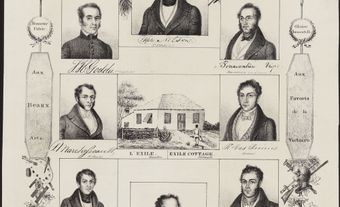This article was originally published in Maclean's Magazine on July 31, 2000
Batoche Bell to Be Returned
By all accounts, the legendary bell of Batoche is a tarnished, unadorned silver-plated object that stands just 30 cm high, and weighs 36 kg. Produced in Spain in the early 1880s and blessed by a Canadian Catholic bishop, the bell hung in a church in the Métis settlement of Batoche, 75 km north of present-day Saskatoon, where it was used to announce Sunday masses, funerals and weddings. But in the tumultuous spring of 1885, after Louis Riel and the Métis mounted an unsuccessful armed resistance against the Canadian government, the bell disappeared. Victorious soldiers from Millbrook, Ont., a farming village 100 km northeast of Toronto, took it home as a war trophy. For Millbrook residents, the bell has long since lost its lustre, but it is still revered by the Métis. "The bell is part of our folklore," says Gerald Morin, president of the Métis National Council. "It almost has spiritual significance."
That said, there was - until likely this week - one small problem with this historic symbol. The bell hasn't been seen, publicly at any rate, for nine years. It hung for several decades in the Millbrook fire hall before being put on display at the local Legion during the 1980s. Métis organizations occasionally tried to recover the bell, but were rebuffed by descendants of the 1885 veterans. And in October, 1991, about a week after a social visit by six Métis activists, there was a break-in at the Legion and the bell was stolen. But it is expected to resurface during the week-long annual Métis celebration, beginning on July 24 at the Batoche battle site. Shortly after Saskatchewan Aboriginal Affairs Minister Jack Hillson last week promised there would be no criminal charges involving the bell, Hillson and Morin said an unidentified person claimed he would present the bell during Batoche 2000. "If it happens," says Morin, "it will be a joyous occasion."
Meantime, a new chapter in the saga of the bell is about to unfold in the Ontario village where it was kept. Millbrook's 4th Line Theatre company, which specializes in historical productions, has turned the story into a play called Crossings (The Bell of Batoche) that opens for a four-week run on Aug. 5. The production is being staged in an unusual venue - a rolling meadow on artistic director Robert Winslow's 100-acre farm just outside the village. Crossings, says Winslow, who co-wrote the drama with native playwright Greg Daniel, goes beyond the story of the bell to explore the forces that led to the 1885 conflict. The 50-member cast includes Métis and Cree actors from Saskatchewan. "I realized there were real political passions behind the break-in at the Legion," says Winslow. "Someone obviously said, 'They've had our bell for 106 years. We're going to get it back.' "
Those passions, say some Métis, can be traced back to 1885, a pivotal year in their history. Batoche, where Riel declared a provisional government, was completely destroyed, never rebuilt, and is now a national historic park. Defeat on the battlefield led to the execution of the charismatic Riel. In most historical accounts, the Métis leaders have been treated as traitors, their followers as rebels and the conflict itself has become known as the Northwest Rebellion. "We didn't write the history books," says Tony Belcourt, president of the Métis Nation of Ontario, "and we very definitely have a different view of 1885."
The Métis perspective will come across loud and clear in Crossings. Cast member Cheryl L'Hirondelle-Waynohtew, a Métis storyteller from Dundurn, Sask., says her people mounted a legitimate and courageous resistance against a distant government that refused to recognize them or grant them title to their lands. "The Métis took up arms after setting up a provisional government," she says. "So you can't say they were rebelling. They were defending their land, and resisting another government."
The task of portraying the motives of the Millbrook men who joined the fight fell to Winslow, whose great-uncle Charles Winslow served in the 1885 campaign. The playwright, who worked for more than a decade as an actor and director in Toronto and Edmonton, inherited the family farm in 1990 and promptly founded 4th Line so he could use the property to stage large, historical dramas. His company has mounted 12 works, all original, starting with a play about the Cavan Blazers, a group of tough, Protestant farmboys from the surrounding township who intimidated Catholic settlers in the 1840s. "This was a very strong Protestant Orange area from the beginning," says Winslow. "In 1885, local men went west to keep Canada British and Protestant."
But even in Millbrook, times changed. Joe McGrail, 61, a retired correctional officer and past-president of the Legion, says some branch members wanted to hold a vote in the spring of 1991 to return the bell to the Métis. They also formed a committee, after the theft, that worked with Métis organizations to try to recover the icon. News that the bell had turned up, at last, was welcomed in many quarters. Winslow said he hoped his finale for Crossings - the return of the bell to Batoche - would no longer be fictional. For his part, Morin said the Métis may have a new hero - the person who brings the bell back to Batoche. And why not? A 115-year odyssey with a happy ending.
Maclean's July 31, 2000

 Share on Facebook
Share on Facebook Share on X
Share on X Share by Email
Share by Email Share on Google Classroom
Share on Google Classroom


